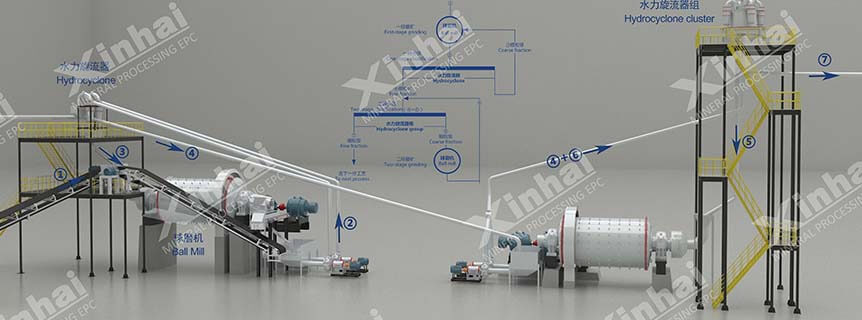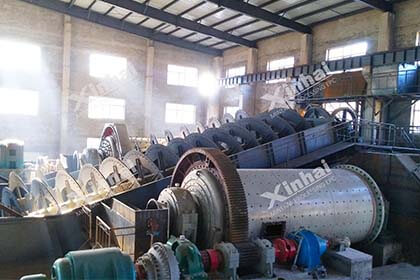What is a Grinding and Classification Automated System?
 Laura
Laura
 Dec 10, 2024
Dec 10, 2024
 721
721
If you want to know more details about equipment, solutions, etc, please click the button below for free consultation, or leave your requirements!

( Two-stage closed circuit grinding )
In the mining and mineral processing industries, efficiency and precision are crucial for maximizing output and profitability. One of the most significant advancements in this sector is the development of grinding and classification automated systems. These systems integrate both grinding and classification processes into a seamless workflow, optimizing the preparation of raw materials for further processing. This article explores what a grinding and classification automated system is, its components, how it works, its benefits, and its applications across various industries.
01What is Grinding and Classification?
Back1. What is Grinding?
Grinding is a mechanical process that reduces the size of solid materials, typically ores, to liberate valuable minerals from the surrounding material. In mining, effective grinding is essential for increasing the efficiency of subsequent processing stages, such as flotation or leaching. Common types of grinding equipment include ball mills, rod mills, and high-pressure grinding rolls (HPGR). Each type of mill serves different purposes and is selected based on the specific characteristics of the ore being processed.
2. What is Classification?
Classification is the process of separating particles based on size or density, ensuring that only materials of the desired size proceed to the next stage of processing. This is critical in mineral processing, as it helps to enhance the efficiency of the grinding operation and improves the overall recovery of valuable minerals. Classifiers can be mechanical, such as vibrating screens and spiral classifiers, or hydraulic, like hydrocyclones, which use centrifugal force to separate particles.
02What is a Grinding and Classification Automated System?
BackA grinding and classification automated system combines both grinding and classification processes into a fully integrated and automated workflow. This system employs advanced technologies, including sensors, control systems, and data analytics, to monitor and optimize operations in real time.
Key Components of the System
1. Grinding Equipment
The heart of the system, grinding equipment includes various types of mills and crushers designed to reduce particle size. Key types of grinding machines are:
1). Ball Mills: Used for fine grinding, these mills utilize spherical grinding media.
2). Rod Mills: These are suitable for coarser grinding and use long rods as grinding media.
3). High-Pressure Grinding Rolls (HPGR): These machines apply high pressure to achieve size reduction, offering energy efficiency advantages.
2. Classifying Equipment
Classifiers separate ground material based on size. Key types include:
1). Hydrocyclones: These devices use centrifugal forces to classify particles in a liquid medium.
2). Vibrating Screens: These machines separate materials using vibration to facilitate size classification.
3). Spiral Classifiers: Utilizing a spiral mechanism, these classifiers separate fine particles from coarser ones.
3. Control Systems
Classifiers separate ground material based on size. Key types include:
Data Management Software: This software collects and analyzes data from the system, providing insights that help operators improve process efficiency and make informed decisions.
03How Does a Grinding and Classification Automated System Work?
BackThe operation of a grinding and classification automated system involves several key steps:
1). Feeding: Raw ore is fed into the grinding circuit, ensuring a consistent feed rate for optimal processing.
2). Grinding: The grinding equipment reduces the size of the ore, while the system continuously monitors particle size to adjust grinding parameters as needed.
3). Classification: After grinding, the material is sent to the classification unit, where it is separated based on size. Finer particles are classified for further processing, while coarser particles may be returned to the grinding stage.
4). Feedback Loop: The system operates on a closed feedback loop, where data from the classification process informs adjustments in the grinding process. This real-time optimization enhances efficiency and ensures the desired particle size distribution is achieved.
5). Discharge: Once classified, materials are discharged for further processing, such as flotation or leaching.
04Benefits of Grinding and Classification Automated Systems
Back1. Increased Efficiency
Automated systems significantly enhance the efficiency of mineral processing operations. By optimizing both grinding and classification processes in real time, these systems reduce processing time and increase throughput.
2. Improved Product Quality
With precise control over the grinding and classification processes, automated systems yield a more consistent particle size distribution. This uniformity is critical for subsequent processing steps, leading to improved recovery rates and product quality.
3. Cost Savings
While the initial investment in automated systems can be substantial, the long-term operational savings often outweigh these costs. Increased efficiency, reduced energy consumption, and lower labor costs contribute to overall cost reductions.
4. Enhanced Data Management
Automated systems provide comprehensive data on the grinding and classification processes, allowing operators to analyze performance metrics and identify areas for improvement. This data-driven approach enhances decision-making and operational planning.
5. Increased Safety
By reducing the need for human intervention in potentially hazardous environments, automation improves workplace safety. Operators can monitor and control the system remotely, minimizing their exposure to dangerous conditions.
05Applications of Grinding and Classification Automated Systems
BackGrinding and classification automated systems are widely used across various industries, including:
1). Mining: In the mining sector, these systems are essential for processing ores such as copper, gold, and lithium, where precise particle size control is crucial for effective mineral recovery.
2). Cement Production: The cement industry utilizes grinding and classification systems to produce finely ground clinker and other materials, ensuring uniformity and quality in the final product.
3). Pharmaceuticals: The pharmaceutical industry relies on consistent particle sizes in active pharmaceutical ingredients (APIs). Automated systems are employed to achieve this precision.
4). Chemical Processing: In chemical manufacturing, automated grinding and classification systems are used to ensure raw materials are processed to meet specific specifications.
06Conclusion
BackGrinding and classification automated systems are vital for modern mineral processing operations, integrating grinding and classification into a streamlined workflow. By enhancing efficiency, improving product quality, and reducing operational costs, these systems play a critical role in the mining and manufacturing industries. As technology continues to advance, the capabilities of grinding and classification automated systems will evolve, offering even greater efficiencies and innovations in mineral processing. Embracing these advancements is essential for companies looking to remain competitive in an increasingly demanding market.
Contact us and learn more about grinding and classification automated system!
 +86 18234403483
+86 18234403483 yanzhang19990421@gmail.com
yanzhang19990421@gmail.com




 Message
Message Chat Now
Chat Now

















